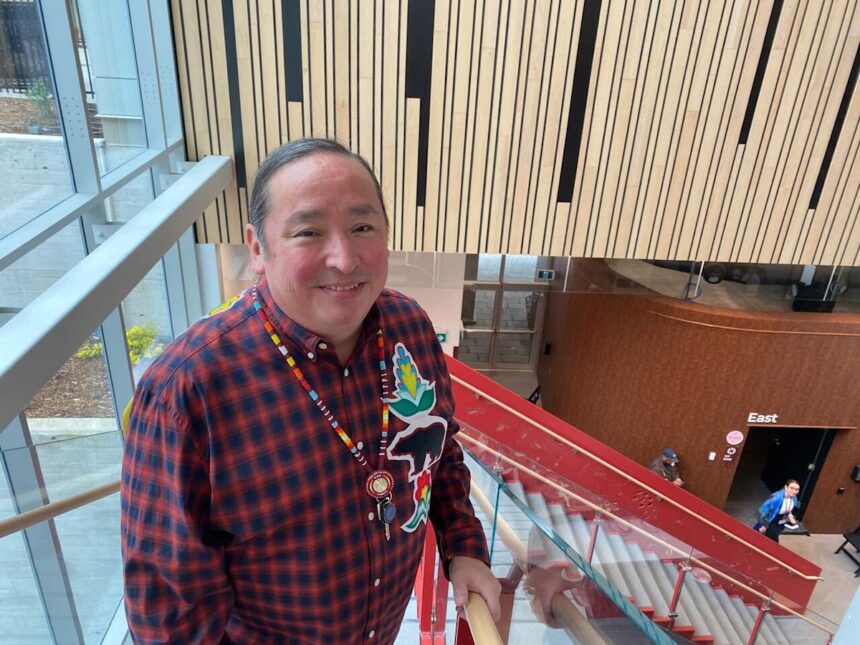The bright autumn sun cast a warm glow over Toronto’s West Don Lands yesterday as community members gathered to celebrate what many are calling a transformative moment for Indigenous healthcare in our city. After years of planning and construction, Anishnawbe Health Toronto’s new Indigenous Health Centre has officially opened its doors at the corner of Front and Cherry Streets.
Walking through the impressive 45,000-square-foot facility yesterday, I couldn’t help but notice how the building itself tells a story. Its circular design elements and abundant natural light create an atmosphere that feels both modern and deeply connected to traditional Indigenous healing principles.
“This isn’t just a building – it’s the physical manifestation of a vision that’s been decades in the making,” explained Joe Hester, Executive Director of Anishnawbe Health Toronto, during the opening ceremony. “For the first time, we have a purpose-built space that honors Indigenous approaches to wellness while providing comprehensive healthcare services all under one roof.”
The significance of this development extends far beyond architecture. For Toronto’s estimated 70,000 Indigenous residents, accessing culturally appropriate healthcare has historically meant navigating fragmented services across three aging locations throughout the city.
Toronto Mayor Olivia Chow, who attended the celebration, emphasized the center’s importance to the city’s reconciliation efforts. “This health center represents what’s possible when we truly listen to Indigenous communities and support their vision for healthcare that respects traditional knowledge and practices,” she noted during her remarks.
What makes the center truly unique is its holistic approach to wellness. Beyond conventional medical services, the facility houses dedicated spaces for traditional healing practices, including a ceremonial room, sweat lodge, and teaching kitchen for traditional food preparation.
Dr. Lisa Richardson, Strategic Lead in Indigenous Health at Women’s College Hospital and University of Toronto, explained why this matters. “When Indigenous patients can access care that respects their cultural traditions and incorporates traditional healing alongside Western medicine, health outcomes improve dramatically,” she told me as we toured the facility.
The center didn’t materialize overnight. Its journey began nearly 40 years ago when Anishnawbe Health Toronto first started offering services from a small storefront. The $35 million project received funding from all three levels of government, corporate partners, and community donations – a collaborative effort reflecting growing recognition of Indigenous health as a priority.
For Mississaugas of the Credit First Nation Chief Stacey Laforme, whose traditional territory includes Toronto, the opening carries profound meaning. “This center stands on land where Indigenous peoples have sought healing for thousands of years,” he said during the blessing ceremony. “Now that tradition continues in a new form that bridges ancient wisdom with contemporary care.”
Community response has been overwhelmingly positive. Sarah Keeshig, a Toronto resident and member of the Wikwemikong First Nation, shared her perspective as we waited for the ribbon-cutting. “Having healthcare providers who understand our history, our traditions, and our specific health challenges makes all the difference,” she explained. “Many of us have experienced discrimination in mainstream healthcare settings, so having a place specifically designed for us feels like coming home.”
The facility’s opening comes at a critical time. Recent data from Toronto Public Health shows Indigenous residents face significantly higher rates of chronic conditions including diabetes and cardiovascular disease compared to non-Indigenous populations. Mental health services are particularly crucial, with intergenerational trauma from residential schools continuing to impact wellbeing.
Looking beyond healthcare, the center anchors a broader Indigenous hub development that will eventually include housing, childcare, and educational facilities. This integrated approach recognizes that health outcomes are deeply connected to social determinants like housing stability and economic opportunity.
André Morriseau, who serves on the board of Miziwe Biik Development Corporation, a partner in the hub project, explained the vision. “We’re creating a community within a community – a place where Indigenous people can access comprehensive services and supports while strengthening cultural connections,” he said.
As our city continues grappling with reconciliation efforts, developments like this provide tangible examples of progress. The center represents what meaningful collaboration between Indigenous organizations, government, and the private sector can achieve when Indigenous leadership drives the process.
Walking back to my car after the ceremonies concluded, I noticed a small group of Indigenous youth performing traditional songs near the entrance. Their voices carried across the courtyard – a fitting reminder that this new health center isn’t just about addressing current needs but about creating healthier futures for generations to come.







